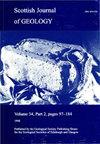Greenburn煤的多阶段黄铁矿成因和表观遗传学富硒(东艾尔郡)
IF 0.5
4区 地球科学
Q4 GEOLOGY
引用次数: 9
摘要
艾尔郡煤田石炭系煤相对于英国和世界的平均成分富含硒(Se),取代了硫铁矿中的硫。绿本露天矿煤的特征为同生块状黄铁矿(约占总面积的15%),呈顺层平行带状分布,后期形成的(后生的)横切黄铁矿在理块中形成(约占总面积的9%)。其中,同生和表生黄铁矿的硫同位素组成均有轻同位素和重同位素变化,提示成岩和热液流体形成。与早期形成的材料(硒含量高达181ppm)相比,晚期/后visean清晰充填的黄铁矿富含硒(高达266ppm)。异常硒可能来源于附近的硫化物变质岩。初始的硒固存与同生黄铁矿矿化有关,从海水和孔隙水中吸收硒,并从表生黄铁矿形成过程中动员的流体中引入额外的硒。局部脆性压裂产生的裂隙为流体流动提供了通道,并为相对高硒黄铁矿的沉淀提供了场所。二叠系白云岩侵入可能提供了富集源和/或流体分布机制。Greenburn煤的硒含量与多阶段成矿作用有关,其中以填空型黄铁矿的硒含量最高,突出了世界范围内类似蚀变和破碎型煤层的高硒潜力。补充材料:从煤层9300 Lime和6900 Burnfoot Bridge获取的Greenburn煤样品的Fe, Se, Ag, As, Cu, Hg, Pb和Te的LA-ICP-MS图可在https://doi.org/10.6084/m9.figshare.c.3967860上获得本文章由计算机程序翻译,如有差异,请以英文原文为准。
Multi-stage pyrite genesis and epigenetic selenium enrichment of Greenburn coals (East Ayrshire)
Carboniferous coals of the Ayrshire Coalfield are enriched in selenium (Se) relative to average UK and world compositions, substituting for sulphur in pyrite. Greenburn surface mine coals are characterized by syngenetic concretionary pyrite (c. 15% total area), occurring as bedding-parallel banding, and later-formed (epigenetic) cross-cutting pyrite in cleats (c. 9% total area). In these, sulphur isotope compositions for both syngenetic and epigenetic pyrite include isotopically light and heavy variants, suggesting diagenetic and hydrothermal fluid formation. Late/post-Visean cleat-filling pyrite is enriched in Se (up to 266 ppm) compared to the earlier-formed material (Se up to 181 ppm). Anomalous Se may have been sourced from near-by sulphidic Dalradian metamorphic rocks. Initial Se sequestration is associated with syngenetic pyrite mineralization, absorbed from seawater and pore waters, with additional Se introduced from fluids mobilized during epigenetic pyrite formation. Cleats from local brittle fracturing provided channels for fluid flow and a locus for precipitation of comparatively high-Se pyrite. Permian dolerite intrusions may have provided an enrichment source and/or fluid distribution mechanism. The Se concentrations of the Greenburn coals relate to multi-stage mineralization, with cleat-filling pyrite showing the highest Se content, and highlight the potential for high Se in similarly altered and fractured coal deposits worldwide. Supplementary material: LA-ICP-MS maps for Fe, Se, Ag, As, Cu, Hg, Pb and Te for Greenburn coal samples from seams 9300 Lime and 6900 Burnfoot Bridge are available at https://doi.org/10.6084/m9.figshare.c.3967860
求助全文
通过发布文献求助,成功后即可免费获取论文全文。
去求助
来源期刊

Scottish Journal of Geology
地学-地质学
CiteScore
1.70
自引率
0.00%
发文量
10
审稿时长
>12 weeks
期刊介绍:
Although published only since 1965, the Scottish Journal of Geology has a long pedigree. It is the joint publication of the Geological Society of Glasgow and the Edinburgh Geological Society, which prior to 1965 published separate Transactions: from 1860 in the case of Glasgow and 1863 for Edinburgh.
Traditionally, the Journal has acted as the focus for papers on all aspects of Scottish geology and its contiguous areas, including the surrounding seas. The publication policy has always been outward looking, with the Editors encouraging review papers and papers on broader aspects of the Earth sciences that cannot be discussed solely in terms of Scottish geology.
The diverse geology of Scotland continues to provide an important natural laboratory for the study of earth sciences; many seminal studies in geology have been carried out on Scottish rocks, and over the years the results of much of this work had been published in the Journal and its predecessors.
The Journal fully deserves its high reputation worldwide and intends to maintain its status in the front rank of publications in the Earth sciences.
 求助内容:
求助内容: 应助结果提醒方式:
应助结果提醒方式:


